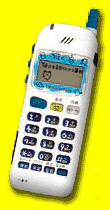Background
First introduced in November 1996, the Tamagotchi (pronounced TAH-MAH-GOH-CHEE) is sold in toy stores, and marketed as "the original virtual reality pet". It might be described briefly as a tiny hand-held LCD video game that comes attached to a key chain or bracelet. The object of the game is to simulate the proper care and maintenance of a "virtual chicken", which is accomplished through performing the digital analog of certain "parental" responsibilities, including feeding, playing games, scolding, medicating, and cleaning up after the ersatz pet . The popularity of this device has been nothing short of phenomenal.
Over four million units have been purchased in Japan since the toys release, meaning that an estimated 3% of the nation's population owns a Tamagotchi. Priced at about $16, stores have consistently sold out of the item, inspiring an entire market of Hong Kong and Tawain based counterfeit toy manufacturing operations. ii Would-be Tamagotchi owners camp-out overnight at stores expecting new shipments the next day, and some consumers resort to purchasing the toy eggs from a black-market dealers, at prices ranging from 20 to 60 times the store price. Enterprising con-men sell fraudulent rain check coupons that can supposedly be exchanged for one of the electronic toys when the next shipment arrives.
In a highly publicized incident, four high school boys bullied a school mate and stole his Tamagotchi. Police employed several patrol cars and a helicopter in the pursuit of the juveniles, and eventually recovered the electronic toy and returned it to the rightful owner.
And after 6 months on the market, the Tamagotchi craze shows no signs of slowing: April 30th the Tobu department store received a shipment of 1000 units, and despite efforts to keep potential customers in the dark about shipping schedules (to avoid enormous lines and unruly behaviour) the new stock sold out in 45 minutes. iii
Bandai Co., the producer of Tamagotchi, is running ads in major newspapers in Japan apologizing for its inability to meet with consumer demand, claiming that the popularity of the toy caught them unsuspected, and that they are in the process of up-grading the output of their production facility in China to 3 million units per month.
Critics suspect Bandai of intentionally undersupplying in order to increase consumer demand. If so, they're in good company - by keeping supply tight for the Nintendo Entertainment System and its subsequent reincarnations (Super Nintendo, Game Boy, and the Nintendo 64), the Nintendo Co. was able to maintain high consumer interest yielding legendary sales figures.iv
That Bandai is milking the phenomenon for all it's worth seems unquestionable: in March the company announced a free give-away of one Tamagotchi to each owner of at least 1000 shares of stock, and the following day the price shot up considerably.v
Some say that the expected $160 million in revenue from the Japanese release of Tamagotchi is a much needed boost for Bandai, suffering from waning interest in Mighty Morphin' Power Rangers and the failed attempt to introduce Sailor Moon Products to America.vi
And predictably, associated merchandizing has appeared, ranging from Tamagotchi shirts, hats, and underwear to stuffed animals, stationary and decals that can be applied to the plastic casing of the plastic game to personalize it. A second generation has been released, with decorated plastic casings, and the hottest item yet is a portable phone with an LCD display that doubles as a Tamagotchi game interface.
What is a Tamagotchi?
Tamagotchi in Japan
